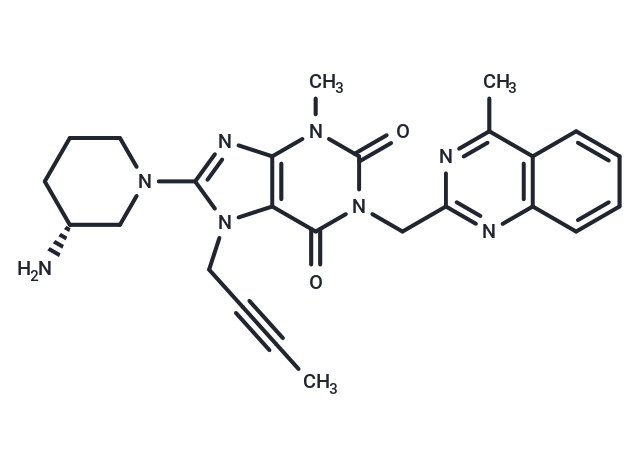Shopping Cart
- Remove All
 Your shopping cart is currently empty
Your shopping cart is currently empty

Linagliptin (BI 1356) is a potent, orally bioavailable dihydropurinedione-based inhibitor of dipeptidyl peptidase 4 (DPP-4), with hypoglycemic activity.

| Pack Size | Price | Availability | Quantity |
|---|---|---|---|
| 50 mg | $38 | In Stock | |
| 100 mg | $54 | In Stock | |
| 1 mL x 10 mM (in DMSO) | $50 | In Stock |
| Description | Linagliptin (BI 1356) is a potent, orally bioavailable dihydropurinedione-based inhibitor of dipeptidyl peptidase 4 (DPP-4), with hypoglycemic activity. |
| Targets&IC50 | DPP4:1 nM |
| In vitro | Linagliptin shows a potent inhibition effect against DPP-4 in vitro and a low affinity for hERG channel and M1 receptor (IC50 295 nM). [1] Linagliptin acts as a competitive inhibitor with a Ki of 1 nM, and also shows 10,000-fold more selectivity for DPP-4 than DPP-8, DPP-9, amino-peptidases N and P, prolyloligopeptidase, trypsin, plasmin, and thrombin, and 90-fold more selectivity than fibroblast activation protein in vitro. [2] |
| In vivo | In male Wistar rats, Beagle dogs, and Rhesus monkeys, Linagliptin exhibits highly efficacious, long-lasting, and potent inhibitory activity against DPP-4 with over 70% inhibition for all three species after oral administration of 1 mg/kg. In db/db mice, oral administration of Linagliptin 45 min before an oral glucose tolerance test reduces plasma glucose excursion in a dose-dependent manner, achieving 15% inhibition at 0.1 mg/kg and 66% inhibition at 1 mg/kg. [1] By inhibiting DPP-4 activity, Linagliptin also reduces the expression of the proinflammatory markers cyclooxygenase-2 and macrophage inflammatory protein-2, and enhances myofibroblast formation in healing wounds from ob/ob mice. [3] |
| Kinase Assay | EDTA plasma (20 μL) is diluted with 30 μL of DPP-4 assay buffer (100 mM Tris and 100 mM NaCl, adjusted to pH 7.8 with HCl) and mixed with 50 μL of H-Ala-Pro-7-amido-4-trifluoromethylcoumarin. The 200 mM stock solution in dimethylformamide is diluted 1:1000 with water to yield a final concentration of 100 μM. The plate is incubated at room temperature for 10 min, and fluorescence in the wells is determined by using a Victor 1420 Multilabel Counter at an excitation wavelength of 405 nm and an emission wavelength of 535 nm. For the detection of DPP-4 activity in wound lysates, 100 μg of protein from the respective wound lysates are used instead of 20 μL of plasma. Active GLP-1 is also detected from 100 μg of respective wound tissue samples and analyzed by using the Mouse/Rat Total Active GLP-1 Assay Kit. |
| Cell Research | A total of 4.0×107 keratinocytes per well are seeded into 24-well plates. After reaching 50% confluence, cells are starved for 24 h with DMEM. Proliferation of cells is assessed by using 1 μCi/mL of [3H]methyl-thymidine in DMEM in the presence of 10% fetal bovine serum and increasing concentrations of linagliptin (3, 30, 300, or 600 nM) for 24 h. Cells are then washed twice with phosphate-buffered saline and incubated in 5% trichloroacetic acid at 4°C for 30 min, and the DNA is solubilized in 0.5mol/LNaOH for 30 min at 37°C. Finally, [3H]thymidine incorporation is determined. |
| Alias | BI 1356 |
| Molecular Weight | 472.54 |
| Formula | C25H28N8O2 |
| Cas No. | 668270-12-0 |
| Smiles | C(C#CC)N1C2=C(N=C1N3C[C@H](N)CCC3)N(C)C(=O)N(CC4=NC5=C(C(C)=N4)C=CC=C5)C2=O |
| Relative Density. | 1.39 |
| Storage | keep away from direct sunlight,store under nitrogen | Powder: -20°C for 3 years | In solvent: -80°C for 1 year | Shipping with blue ice. | |||||||||||||||||||||||||
| Solubility Information | DMSO: 5.63 mg/mL (11.9 mM), Sonication is recommended. H2O: < 1 mg/mL (insoluble or slightly soluble) Ethanol: 1 mg/mL (2.12 mM), Sonication is recommended. | |||||||||||||||||||||||||
Solution Preparation Table | ||||||||||||||||||||||||||
Ethanol/DMSO
DMSO
| ||||||||||||||||||||||||||

Copyright © 2015-2025 TargetMol Chemicals Inc. All Rights Reserved.